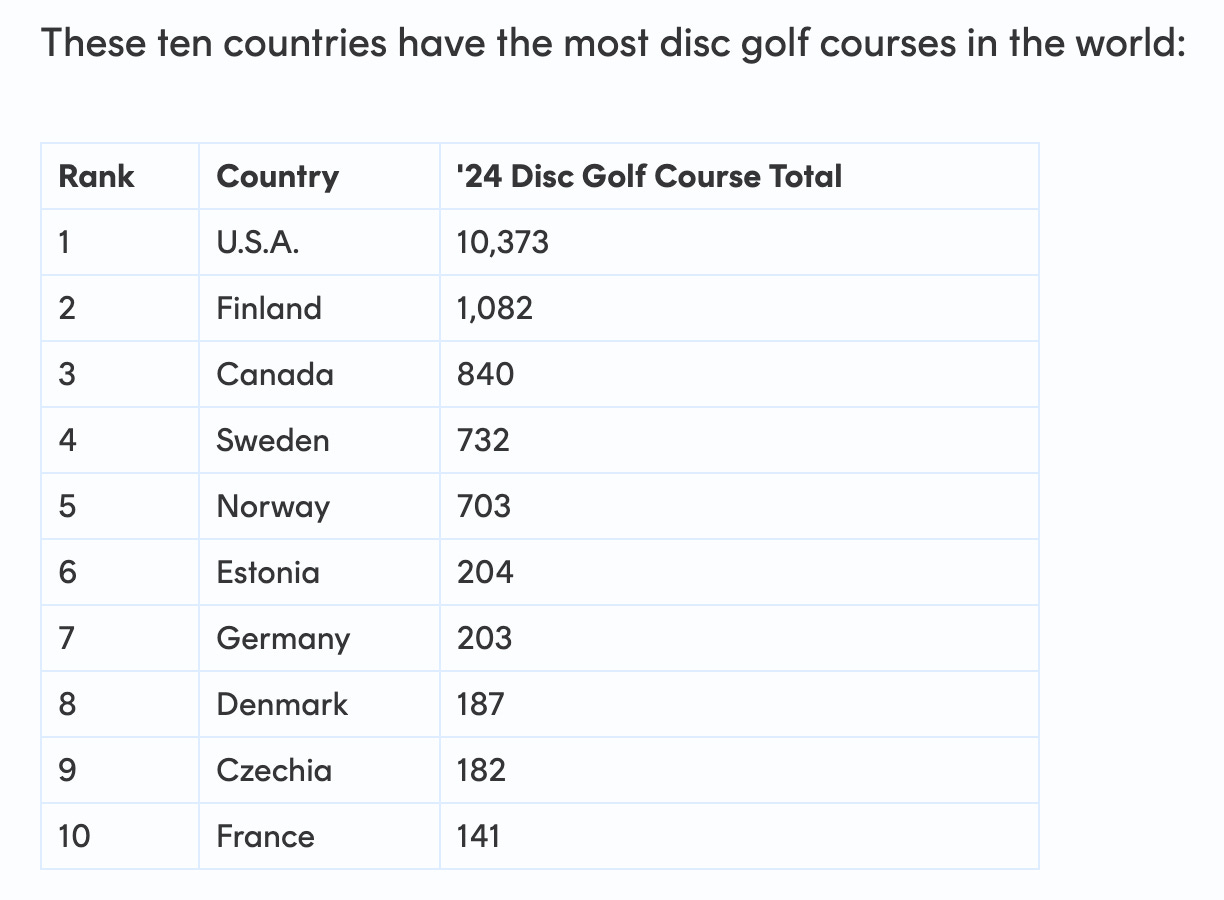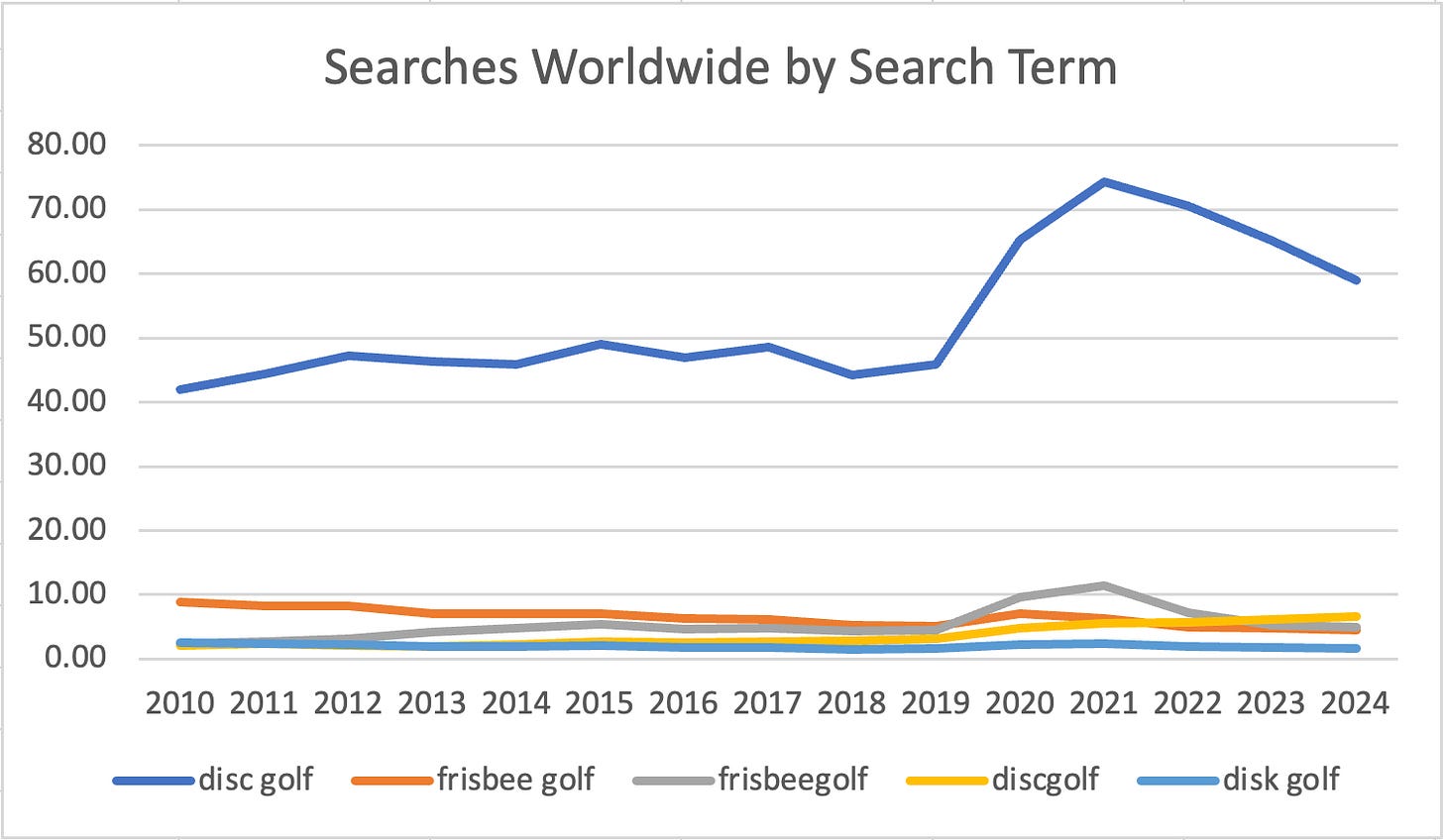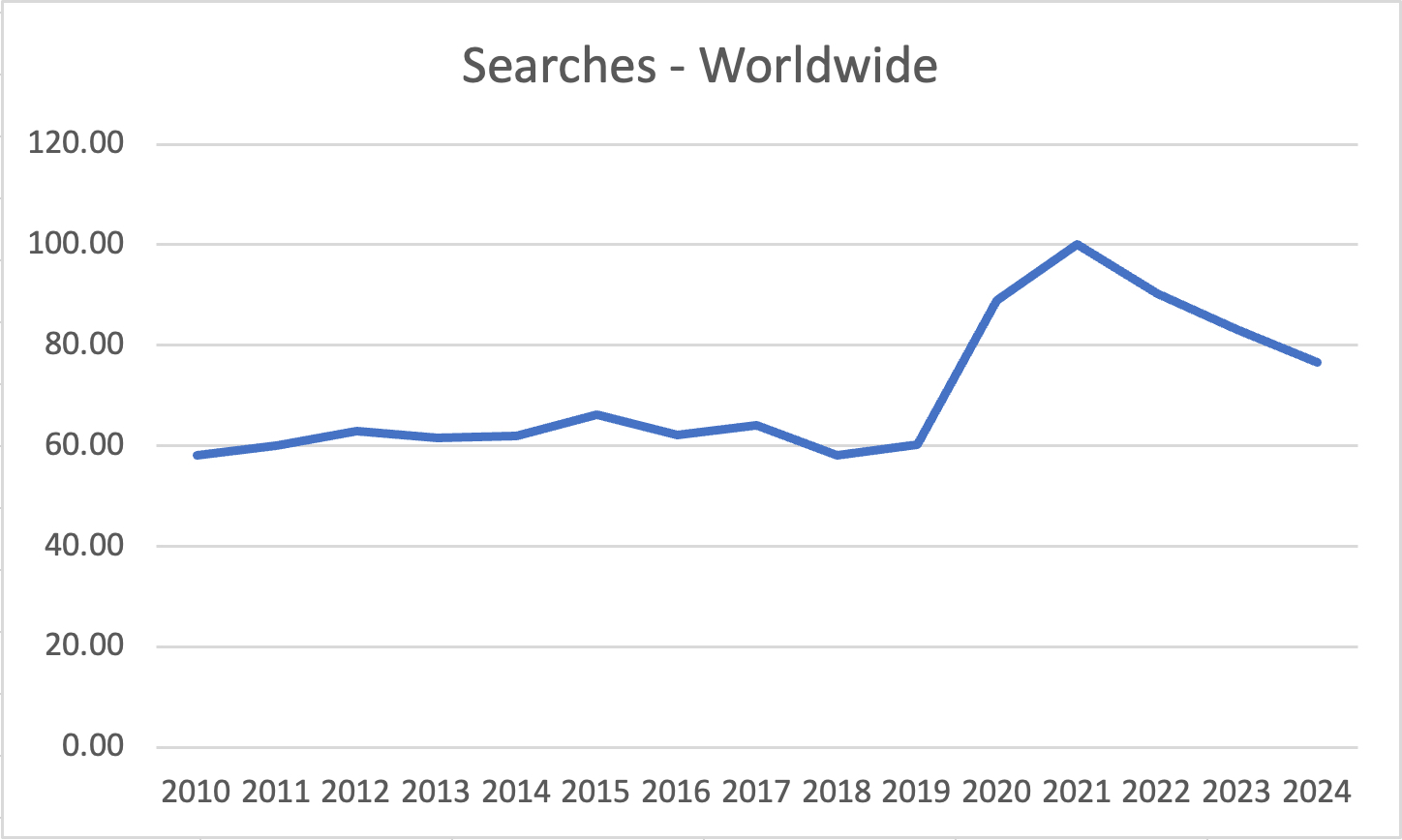Trends in Worldwide Searches for Disc Golf
Analysis of the volume of Google searches worldwide during 2010-2024 for terms for disc golf
In the prior post, I analyzed the data for the volume of Google searches in the United States during 2010-2024 that included terms for disc golf. Since Google is not only the dominant search engine in the US but also in the other parts of the world where disc golf is popular, this post analyzes the data for the volume of Google searches worldwide during 2010-2024 that included terms for disc golf.
In order to analyze trends in Google search volume for disc golf worldwide, I needed to aggregate the data for searches using each term for disc golf that is used anywhere in the world that might have been used for a material percentage of searches relating to the sport. To determine what those terms were, I first needed to determine which countries might have had a material percentage of the total worldwide searches relating to disc golf. I was aware that UDisc published information on the number of disc golf courses in various countries, and I assumed that the countries with the most disc golf courses would also be the countries with the greatest volume of disc golf-related searches. I therefore first sought to identify those countries that had a material percentage of the worldwide number of disc golf courses.
Set forth below is a table from a UDisc blog post published in August 2024 listing the countries with the largest number of disc golf courses.
In its 2024 Disc Golf Growth Report published earlier in 2024, UDisc stated that there were then 15,205 disc golf courses worldwide, of which 10,063 were in the United States. That means that, at the time, 66.2% of all disc golf courses were in the US. Assuming the percentage remained the same, that would mean that, at the time the table above was published, there were approximately 15,669 courses worldwide. Since the aggregate number of disc golf course in the countries listed above (including the US) is 14,647, the courses in the listed countries probably represented over 93% of all disc golf courses worldwide. In addition, since the number of disc golf courses in France was less than 1% of the number of disc golf courses worldwide, it seemed safe to assume that the number of disc golf-related searches in any country not on the list would probably not be material to worldwide search volume.
Based on ChatGPT4o queries and Google Trend searches, the terms for disc golf most commonly used in each of the non-US countries in the table above are as follows (in order of frequency of uses in Google searches):
Finland: frisbeegolf, disc golf, frisbee golf, discgolf
Canada: disc golf, frisbee golf, disk golf, discgolf
Sweden: discgolf, disc golf, frisbeegolf, frisbee golf
Norway: disc golf, frisbeegolf, discgolf, frisbee golf
Estonia: discgolf, disc golf
Germany: disc golf, discgolf, frisbee golf
Denmark: disc golf, discgolf, frisbee golf
Czechia: discgolf
France: disc golf, disque golf
In Google Trends, of the terms used above, together with the terms most commonly used in US searches, the only ones that registered a blip in worldwide search volume were (in order of usage): disc golf, frisbee golf, frisbeegolf, discgolf, and disk golf. (Sorry francophiles, “disque golf” did not make the list.) Set forth below is a chart showing the average monthly volumes of Google searches on the web worldwide using those five terms for each year from 2010 to 2024. (The numbers on the left scale are the percentage that the average monthly search volume for a year represented of the all-time highest monthly search volume for any of the terms during the time period (which happened to be “disc golf” in July 2021).)
As can be seen, “disc golf” was by far the most common search term used for the sport worldwide throughout the time period. Uses of “frisbee golf” declined during the period, while use of the primarily European terms “frisbeegolf” and “discgolf” increased during the period.
To get a measure of the search volume for the sport of disc golf, regardless of which term was used, I summed the data for each of the five terms. Set forth below is a chart showing the average monthly volume of Google searches on the web worldwide for each year from 2010 to 2024 that included any of the five terms for disc golf. (The left scale is the same as for the prior chart.)
As in the case of searches in the US, the average monthly volume of searches worldwide for each year from 2010 to 2024 that included any of the five terms for disc golf was fairly flat from 2010 to 2019, increased dramatically from 2019 to 2021, and has declined significantly since then.
The chart below adds a line that shows what the average monthly volume of searches worldwide from 2010 to 2024 that included any of the five terms for disc golf would have been had it increased from 2010 to 2024 on the trendline from 2010 to 2019.
As in the case of searches in the US, despite the precipitous dropoff from 2021, the volume of worldwide searches in 2024 was still above what it would have been had the volume of searches merely continued to increase from 2019 to 2024 on the trendline from 2010 to 2019.
And, finally, here’s the chart of worldwide searches to which I added the data for US searches.
It’s not worth comparing the absolute numbers of the two lines because the scales are different (the scale for worldwide line is based on 100 being the highest monthly search volume for the term “disc golf” worldwide, while the scale for the US line is based on the highest monthly search volume for the term “disc golf” in the US). However, the differences in the shapes of the two lines are worth noting. The differences in the two lines show that searches for terms for disc golf worldwide increased sharply when the COVID pandemic occurred, declined sharply in 2022, and the decline tapered off a bit in 2023 and 2024, while searches for terms for disc golf in the US increased somewhat less sharply when the COVID pandemic occurred, declined less sharply in 2022 and 2023, but declined more sharply in 2024.
In the next post, I will evaluate how other existing metrics might correlate with the trends in the growth of disc golf.








